This year, for beginning rhetoric literature work, my oldest daughter has been assigned to study Pride and Prejudice (Jane Austen), Les Miserables (Victor Hugo), Huckleberry Finn (Mark Twain), and Crime and Punishment (Fyodor Dostoyevsky) to name a few. While she reads the books in their entirety, I am fortunate enough to have teacher’s notes to gain a reasonable enough grasp of the plot in order to enter into discussions about the the form and content of the said literature with her. It’s too bad I didn’t have these teacher’s notes back when I had to make a book report on either Grapes of Wrath, Anna Karenina or Wuthering Heights in high school or when college philosophy classes required that we read Les Miserables. I have to admit, I don’t think I ever got through any of these books completely.
It is very different with my children though, even at a surprisingly young age. I was quite amazed at how my 9-year old son listened in when I was reading Jane Eyre to one of my older daughters a month ago. Even our 7-year old laughs heartily whenever we enjoy watching a film adaptation of our copy of Much Ado About Nothing (thus, we had to own the original text as well). Exposure to easy translations have made it quite easy for them to take on original versions of the great books. This has been one of the benefits of the literature-rich education we have endeavored to provide them at home.
Picture book editions usually begin our reading adventure (these were found in what used to be our favorite section of the library). Then, as soon as the children are reading with ease, the adapted versions (we used to get from Walmart and I didn’t even think too much of) become enjoyable. In the same way, listening to audio book versions during our long land trips during the summer as well as the reading aloud at home served to familiarize them with literature well beyond their reading level.
All but one of the children have gone through most of the Classic Starts as well as the Great Illustrated Classics series between the ages of 6-8 years (outside of our school curricula). I often hear them talk among themselves about characters in these books. Just the other day, I asked my 7-year old daughter (while we were both sprawled on the bed) to tell me back what she has read from Sign of the Beaver (a Sonlight Core 3 book). As she was narrating to me from where we left off, she animatedly talked about the 12-year old protagonist having read Robinson Crusoe several times and how he talked about this and that character. It was obvious that her familiarity with the book mentioned within the book increased her appreciation of the story at hand.
As years went by, when the original publication caught their eye in one of our library visits (and now in our shelves), there was no stopping them from amusing themselves with those as well.
And when these have proved to be painless enough to pore over, not having been acquainted with the younger editions did not become a stumbling block to understanding the unabridged volumes of other titles either.
This was true for any book and in whatever field. Interestingly, this is quite the case with how the children delight in reading the Bible as well. Here are some of the Bible versions we have managed to collect.
My prayer is that their appreciation of the written word will be an aid in their understanding of God’s precious Word that they may love Him with all their hearts. all their strength, and all their minds.
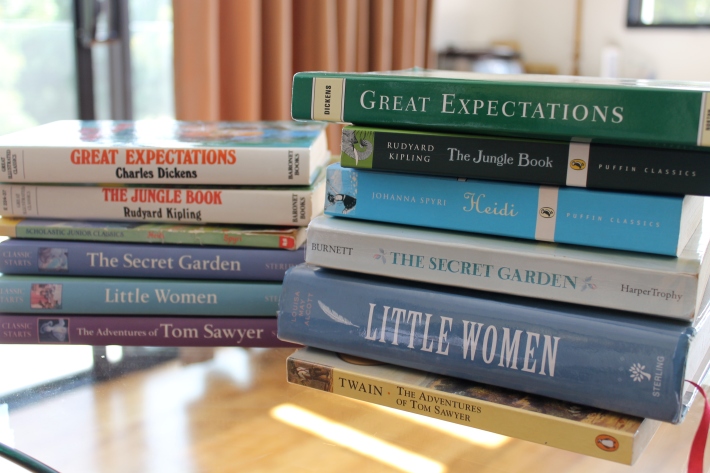


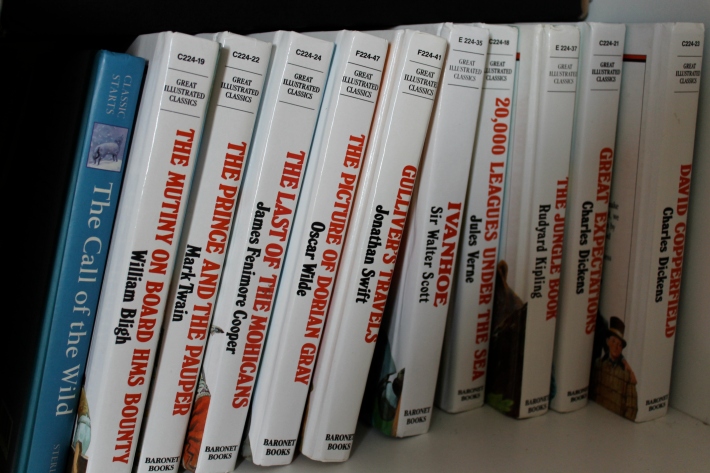
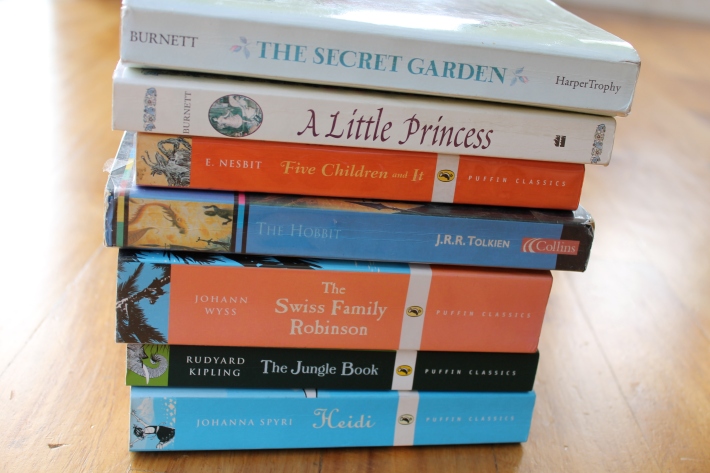




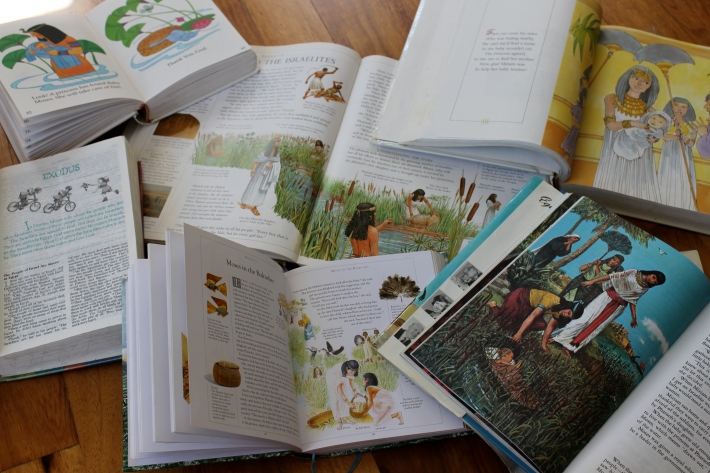
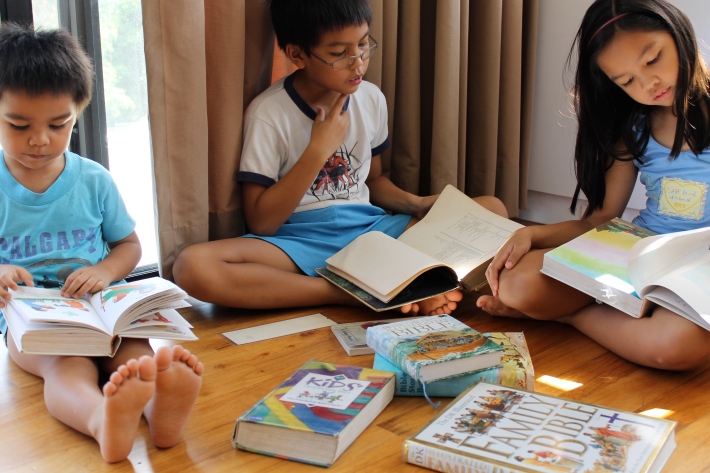
So true! I remember having my Picture Bible (comic book form) and how that truly helped in grasping the stories and timeline. Eventually it helped me understand the Bible better and I often find myself remembering the pictures when I read scripture. Interesting!
We have lots of your old books here. Miguel is reading your copy of Black Beauty right now…
Love your post Winnie. We are just starting with the classics now — and everyone is enjoying. including me!
Though been thinking of posting about this some time ago, our conversation last Friday inspired me to finally write it. Love what you shared about reading “Charlotte’s Web” to the kids.
My kids would love to visit your library! What do you do when you catch them reading instead of doing schoolwork?
Am sure my kids would be delighted to have yours (and interact with them) since, as you say, they have the same enthusiasm for the written word.
Thinking here if I’ve come across the situation you described but don’t recall this ever being the case. I guess it helped that they have developed a habit of doing “school work” (w/c also includes reading history and literature books) first before “fun reading” (all those not included in whichever said program such as Sonlight for the younger ones or Tapestry of Grace for the older ones). Maybe, it’s because they have enough assigned reading (to oneself and listening to read aloud) and that these also tend to keep their interest? Not that I would say the case of catching kids reading good literature – as part of “school” or not – is a problem. Sorry, hope I’m making sense? 😦
It wouldn’t be so much of a problem if they didn’t read during schooltime, like while doing Math and Grammar. My second son is distracted and the youngest just wants to read all day! They would have read the entire Core if I had not stored the books we wouldn’t be doing this year (I split it into two years). Now I write down the time they start doing written work and if they’re not finished, we move on. they do it later before dismissal.
we’re only on our second year and maintaining the discipline to stick to a routine is quite hard for them (for me, too!!) when we do school in the room where our library is. if i’m not vigilant, they’ll sneak in a book (usually a sonlight book) while doing school. this happens when i’m finished with one and still not yet ready to look over another one’s work/do “together-work.” are your books stored in your schoolroom?
they’re improving at sticking-to-schoolwork/doing-things-on-the-schedule, though, which is another benefit of HSing that i see – practicing self-control to finish assigned work, something i’m sure some college students still need to master.
Yes, I think you develop habits in time, so just keep at it.
I took a peek at your sight again to make sure…I think boys are a little different from girls? My two older ones are girls (now 15 and 13) and it seemed natural for them to stick to a desk to do workbook type of work. The son that followed (four years after the second) might have had this “problem” you mention here (distracted a lot of times or unable to focus on work at hand) except his older sisters, by the time he began “school” have already set the example. I think I shared a bit about this issue we had with this child in a post called “The Role of Discipline” under “faith”. What we did with him seemed to have worked then and ruled out the “discipline issue”.
That said, I still try to be flexible. I am always tempted to put him in the same “box” or path that his sisters took when his learning style and temperament might be very different. Homeschooling affords us this excellent privilege. Because of him, I’ve become more hands-on and tactile in our school (doing experiments or crafts or nature studies more often).
Also, I recently was reminded that we can juggle schedules around so that different faculties are engaged in school work that precedes another. For example, if he’s doing Math first (and writing a lot), I follow it with something like Science (where he just has to read, do an experiment, or orally answer questions in the Core to me). Then, he can do something writing-intensive again like grammar exercises. After which, he can do memory work in Bible, geography, and poetry. Short lessons are also always suggested (and said to be more beneficial) especially for younger children (15-20 mins per subject?)
I believe the whole Sonlight idea about living books was inspired by the famous educator Charlotte Mason. If you research more about her style of education, it is very literature-heavy. It recommends doing nature studies (and keeping a nature book) for Science. She believes children should just do “work” half of the day and “play” in the afternoon. And yet, she advocates the development of healthy habits and discipline. I believe the ideas of narration, copywork and dictation also originated from her philosophy. I have only read about her through the book “The Charlotte Mason Companion” by Karen Andreola but if you google her name, I’m sure you’ll read a lot about her style of teaching in the internet.
I don’t know but the situation you described about your children just reminded me of the Charlotte Mason way (maybe since they seem to be very fond of literature?). It’s always great to mix and match the approaches we take when we homeschool especially with lots of children (where our tendency is to create a “course” for all the kids (for me, it saves money, too, to have them all use the same curricula). So, while our Classical leanings tend to make us school more intensively, I really make an effort to be more “Charlotte Mason” even if this is not my own inclination.
Yes, all our books are in the study and accessible. They are free to take anything and read (just wish they would return them consistently!). Also, the way you describe your voracious readers, I think splitting the Core into two is torture to them. We’re trying to do Core 3 and 4 in a school year and a half just so we can be in sync with the older ones who will be doing the Ancients next year.
Hope this helps even just a bit.
Thank you for your lengthy reply. I love reading about others’ experience and advice, especially when it comes from veteran homeschoolers like you, more so when it comes from Filipino HSing moms (and I’ve been trying to find them).
You are right, it is partly a discipline problem, a character issue. Character training is, to me, the hardest subject to teach because I am still a work in progress when it comes to the area of self-discipline.
We’re now implementing Charlotte Mason’s approach in science after their academic consultant told me to veer away from worksheets, etc… we’ve also shortened our lessons in grammar and science to 15 mins/session, just a concept a day which we review for the next 2-3 days because i’ve found that they get confused if a introduce two concepts at once.
About splitting the Core – I really had no choice because this schoolyear has seen two great upheavals in our life: we moved house then went home to the Philippines for two months two weeks after we moved house. and since we’re enrolled with TMA, we have to study Philippine Civics and finish school in one year.
Having said all the above, I’m really glad to have found your blog through Mommy Talks! I’m sure I’m not the only one who appreciates what you share. I think you’re very brave for HSing independently (still have questions concerning that but I’ll reserve them for later).
Yeah, I meet regularly (or we try) with Chris of Mommy Talks and we learn from each other as well. We are fortunate to live nearby.
Thanks to you too! Like I always say, the only difference between us is the years we’ve been homeschooling. I was once just like you and eager to get guidance from others who have already marked the trail. It’s a really a fun and challenging adventure. And as you progress, you’ll find the best way to go in the context of your unique family situation.
I guess the important thing to always remember is that He who called us to do this will be our provision and our guide. It will be a delight to “accomplish” things as we advance but we should keep in mind that all is possible only through Him. We are all work in progress – either groping unconfidently or gloating in our prideful achievements but that is not what all this is supposed to be about. We (reminding myself this) are to hold “homeschooling” as loosely in our hands as we are to do everything else before our Lord.
Keep in touch!
Pingback: Spiritual Food | living and learning